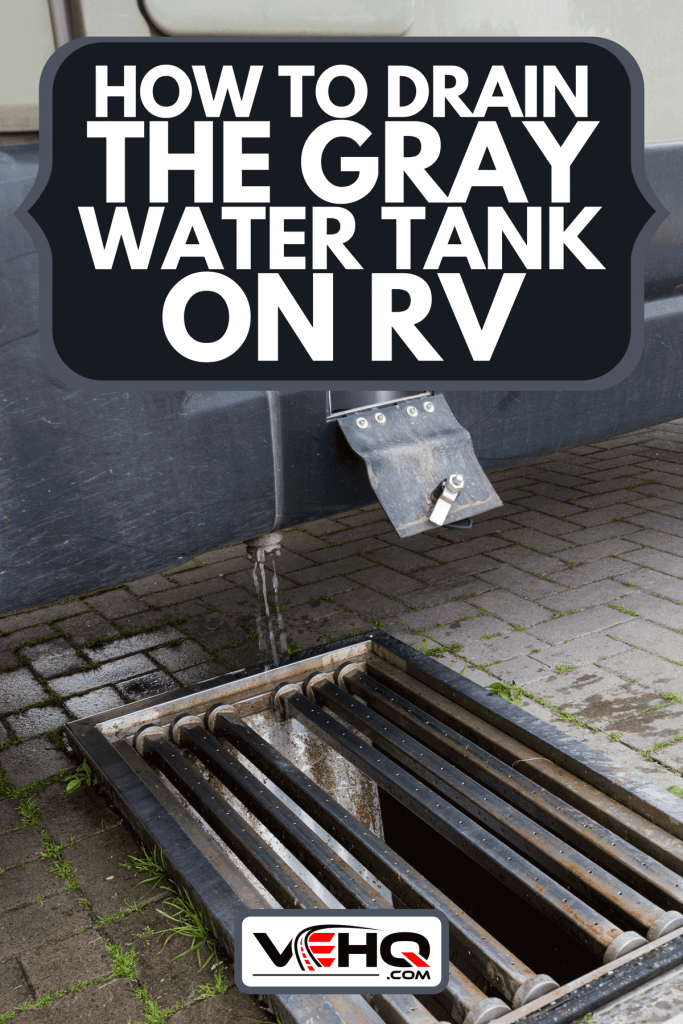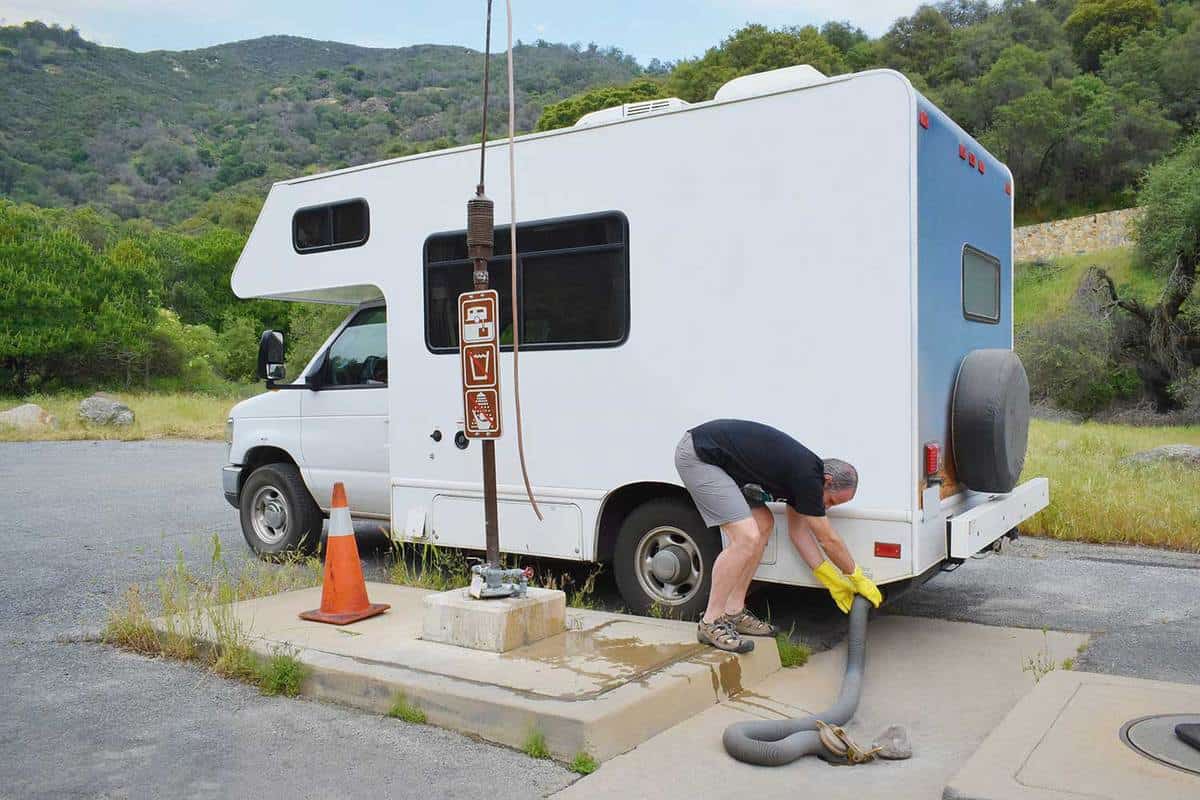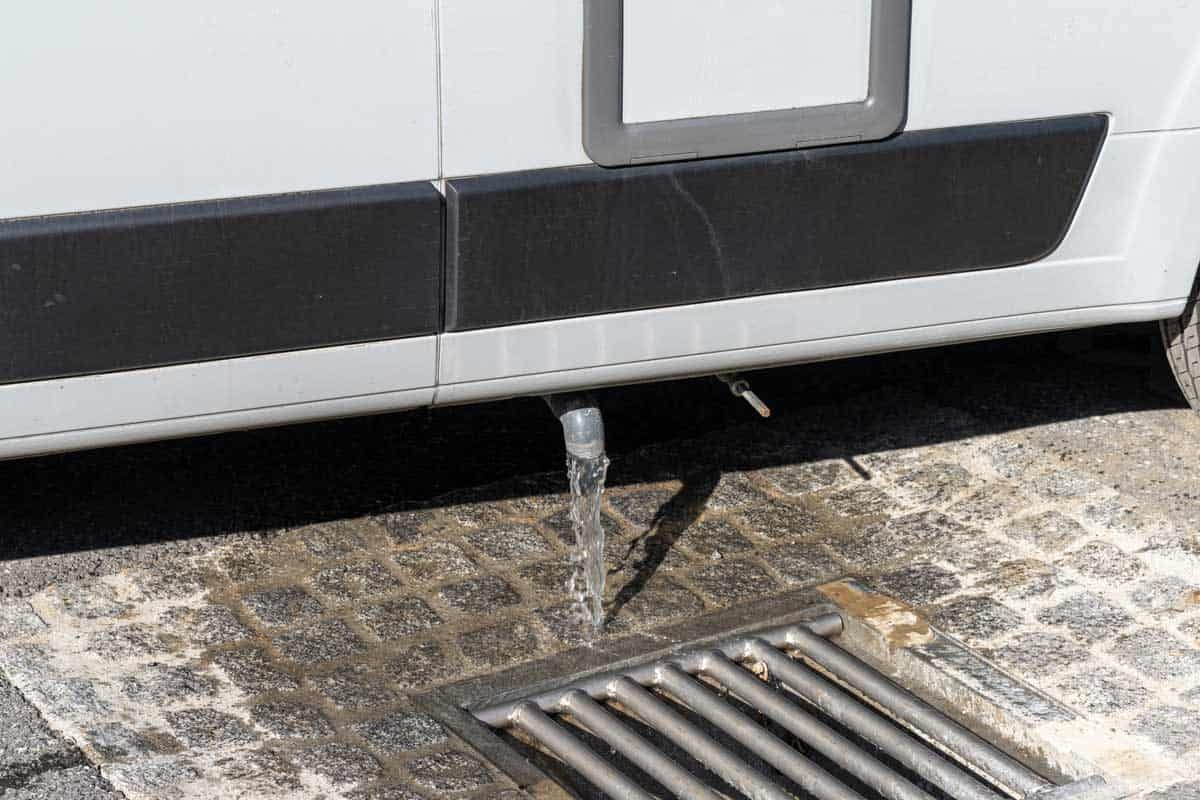If you're a novice RVer, the number of new things you need to learn may seem overwhelming. One of the most important — and dreaded — tasks is draining the wastewater from your RV's holding tanks. The gray water tank, which holds wastewater from your shower, bathroom sink, and kitchen sink, fills up quickly. So, how do you drain the gray water tank on your RV? We've done the research, and we have the answers for you!
Follow these steps to drain the gray water tank on your RV:
- Open the dumping station drain and insert your drain hose.
- Attach the top end of your drain hose to the gray water tank outflow valve.
- Open the gray water outflow valve and allow the tank to drain.
- Close the outflow valve and remove your drain hose.
- Rinse the drain hose.
- Remove your drain hose from the dumping station's drain, then coil and store it.
- Pour gray water tank treatment into the gray tank.
In the remainder of this article, we'll elaborate on each of these steps and discuss why you should never drain gray water onto the ground. We'll also explain what happens when your gray tank is full and offer troubleshooting tips if it isn't draining. Finally, we will discuss the appropriate size of a gray water tank and whether you can put bleach into it. Keep reading to learn all about gray tank wastewater disposal!

How To Drain The Gray Water Tank On RV
Often when you visit the RV dumping station you will want to drain both the black water and gray water tanks. In this case, always dump the black water tank first and then the gray tank.
Although this article describes how to drain the gray water tank, you can easily adapt it to cover those instances when you need to drain both tanks. Simply apply Steps 1 through 4 to the black water tank, transfer the top end of your drain hose to the gray water tank's outflow valve, and apply Steps 2 through 7 to the gray tank.

1. Open The Dumping Station Drain And Insert Your Drain Hose
Lift the lid on the dumping station's drain. Uncoil your RV's drain hose and insert its bottom end into the drain. Make sure that at least the bottom 4" to 5" of the drain hose is inside the drain to avoid the wastewater splashing out. Tilt the drain's lid forward until it leans on your drain hose. This will help keep the drain hose from coming out of the drain during the process of emptying the tank.
Click here for RV drain hose kit on Amazon.
2. Attach The Top End Of Your Drain Hose To The Gray Water Outflow Valve
Remove the cap from your RV's gray water outflow valve, then attach the top end of your drain hose to the outflow valve.
Use a sewer hose support system to keep your drain hose off the ground and avoid kinks or dips that might impede the flow of wastewater. The support system consists of an interconnected series of C-shaped plastic props that unfold like an accordion. The drain hose sits loosely in the semicircular portions of the props.
Click here for drain hose support kit on Amazon.
3. Open The Gray Water Outflow Valve And Allow The Tank To Drain
Once the top of the drain hose is securely affixed to your RV's gray water outflow valve, open the valve and allow the wastewater from your gray tank to flow through the hose and into the dumping station's drain.
Click here for replacement gray tank outflow valve on Amazon.
4. Close The Outflow Valve And Remove Your Drain Hose
When the gray water tank is empty, close the outflow valve. Detach your drain hose from the outflow valve. Be careful: the hose will still have a small amount of water in it, and you don't want this to drip onto your skin or clothing. Replace the cap on the outflow valve.
Click here for replacement valve cap on Amazon.
5. Rinse The Drain Hose
Use the dumping station's non-potable water hose to rinse out your drain hose. Allow the water to run down through the drain hose and into the dumping station's drain. Return the non-potable water hose to its place.
6. Remove Your Drain Hose From The Dumping Station Drain
Lift the dumping station's drain lid off your drain hose. Remove the RV drain hose from the dumping station's drain. Replace the dumping station drain's lid. Wipe down the outside of your drain hose with sanitizing wipes, paying special attention to the ends. Coil and store your drain hose.
7. Pour Gray Water Tank Treatment Into The Gray Tank
Once the gray tank is empty, and its outflow valve closed, pour the recommended amount of gray water treatment down the drain in the shower pan.
Click here for gray water tank treatment on Amazon.
This YouTube video demonstrates the process of draining wastewater into an RV dumping station's drain:
Can You Drain RV Gray Water On The Ground?
In most places, it is illegal to dump your gray water on the ground or into a body of water. Although the laws vary from state to state and on different types of federal lands, it is wisest to assume that you must dump your wastewater in a dumping station, city sewer, or private septic tank.
Legality aside, draining your gray water on the ground is harmful to the environment where you are camping. Gray water contains chemicals, grease, hair, cooking waste, trace amounts of human excrement, and bacteria. To preserve the natural environment that most RVers love so much, don't dump your gray water on the ground!
If you plan to boondock long enough to overreach the capacity of your gray water tank, purchase a portable tank like the one shown below. Drain your excess gray water into it and empty it the next time you're at an RV dumping station.
Click here for portable waste tank on Amazon.
What Happens When Your Gray Water Tank Is Full?
Your gray water tank has sensors and a gauge to let you know how full it is. However, sometimes older gauges malfunction or the sensors in your tank can become covered with paper or other waste. If this happens, you may not know when it's time to empty the gray water tank. In this case, your first indication that the tank is full will be when water backs up through your shower drain.
As soon as you notice gray water in the shower pan, stop using your shower and sinks. Drain the gray water tank immediately. Otherwise, the contaminated water may overflow the shower pan, causing damage to your carpet, subflooring, and cabinetry. A serious flooding incident can leave you with mildew and foul odors throughout your RV.
Why Is My RV Gray Tank Not Draining?
There are three major reasons why your gray water tank might not drain.
Clogged drain hose
This is the simplest problem to identify and fix. Close the outflow valve and detach the drain hose. Then flush the drain hose with water from the dumping station's non-potable water hose. When water runs freely through your drain hose, it is free of clogs.
Clogged gray water tank outlet
If the gray water tank isn't flushed regularly, sludge and solid matter can build up in the bottom, blocking the outflow valve. You can fix this problem by pouring very hot (near-boiling) water down the shower drain. If that doesn't work, pour RV-safe drain cleaner into the shower drain.
Broken outflow valve
If you're certain there are no clogs in the hose or tank, check the outflow valve. Turn its handle to the "closed" position and then back to the "open" position. If the handle turns but the valve doesn't open, you may need to replace the valve.
Click here for RV drain opener on Amazon.
Can I Put Bleach In The Gray Water Tank?
Never put bleach in any of your RV's water tanks. Its caustic chemicals will cause the rubber seals and gaskets on your tanks to dry and crack. Instead, use cleaning and/or disinfecting solutions that are specifically designed to be used in RVs.
How Big Of A Gray Water Tank Do I Need?

The size of the gray water tank you need depends on two things: how many people will be using water, and what they will be using it for. If you're a family of five and everyone showers every day, you'd be wise to install the largest gray water tank possible. At the other end of the spectrum, if you're traveling alone and prefer to shower at truck stops (or not at all!), you may be able to get by with a fairly small gray water tank.
To calculate the size of your optimal gray water tank, think about what daily tasks will add water to the tank. For example, most RV showerheads flow at 2 gallons per minute, so a 5-minute shower will add 10 gallons of gray water to the tank.
Washing dishes uses about 2 gallons for each load of dishes. And hand-washing generally adds about 2 gallons per day, per person. Using these guidelines and figuring how much space and weight you can afford to reserve for your gray water tank, you can decide what size tank is right for you.
In Closing
Now that you know all about how to size, empty, maintain, and troubleshoot your RV's gray water tank, you can hit the road with confidence that you'll never have an overflow!
You may also enjoy:







